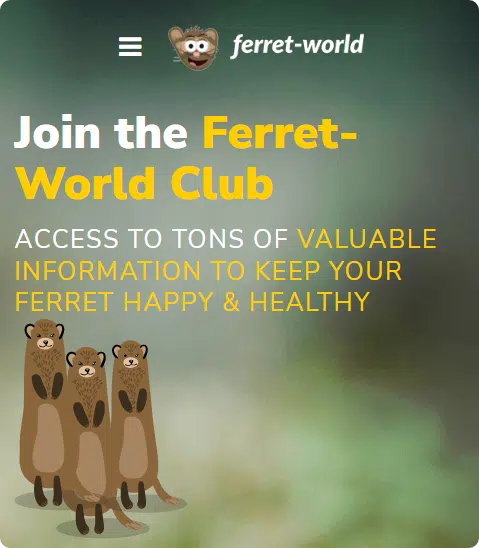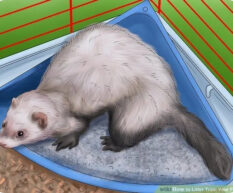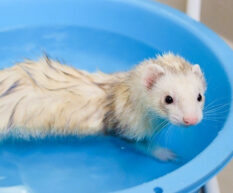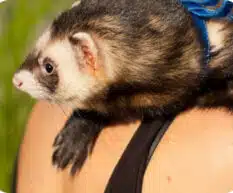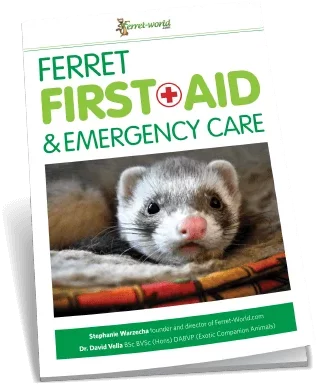Ferret News
Ferret Toys' Environmental Impacts & 3 Eco-Friendly DIY Ferret Enrichment Ideas
By Jazmin "Sunny" Murphy
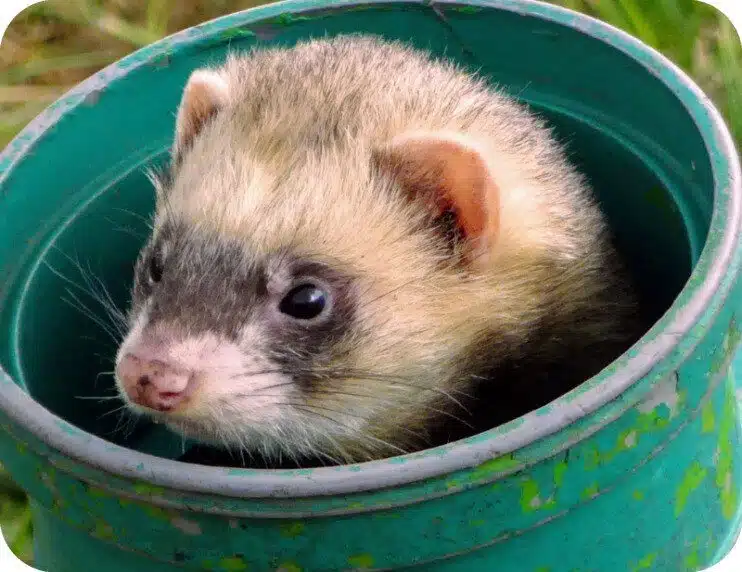
Pet toys can be surprisingly bad for the environment. But only when you don’t know how to provide eco-friendly enrichment.
See, ferrets are simple creatures. It doesn’t take much to entertain them, meaning you don’t have to accumulate a bunch of environmentally harmful stuff for your ferret’s sake.
Here’s how those plastic, mass-manufactured pet toys are hurting your ferret and the earth, and three alternatives you can use to chip away at your environmental impact while keeping your weasel happy.
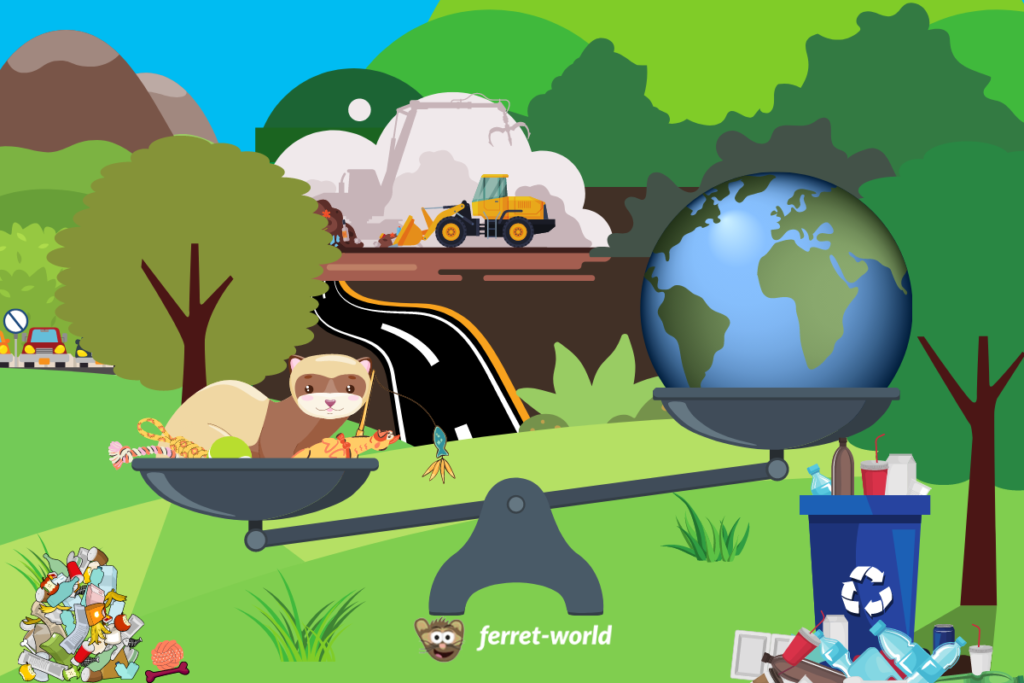
Environmental impacts of pet toys
Scientists have grown increasingly concerned about the environmental impacts of the mass production of commercial pet toys and food in recent years.
Georgia Tech Masters student, Cheyenne Raker, reports that 634 million dog toys end up in landfills nationwide each year, accounting for up to 40,500 tons of waste. This is equal to the area taken up by 26 Hartsfield-Jackson Atlanta airports.
Raker writes, “These numbers are a result of planned obsolescence due to their short life cycles. Pet businesses induce consumerism by offering dog toys with a limited useful life and therefore creating repeat purchases.”
Ferret owners often turn to dog and cat toys (e.g., Kong® toys, plush and plastic balls, chew sticks, etc.) to entertain and enrich their weasels. Because of this, it’s crucial to know just how extensively your product choices can damage local environmental health, and therefore, your own.
What makes ferret toys eco-friendly?
To develop a sustainable pet toy with a lower environmental impact than many of those on the market today, Raker initiated a thorough investigation into the pet toy production process, researching the following factors:
- Choice of materials
- Sustainable solutions to present toy manufacturing processes
- Life cycle assessments for improving toy design
Raker also ensured that the future development of dog toys was informed not only by intensifying environmental damage but expert guidance as well via interviews with industry and academic experts and investigative visits to pet stores.
The researcher noted that one of the most common complaints about these toys is that pets rip them up within just a few days or weeks. This issue extends to ferret owners, too, many of whom have warned against purchasing Kong® toys for ferrets since they’re not as durable as you might expect.
Estimates show that the average buyer of dog toys (whether you have a dog, ferret, or another fur-baby) adds about ten toys to landfills each month. Although pet owners and industry players have attempted to mitigate the millions of toys that end up in the garbage every year, it turns out that one of the most common go-to “solutions” is essentially obsolete.
We haven’t done enough to make pet toys safe for animals and the environment
Raker’s findings showed that recycling is unreliable as a primary means of reducing environmental damage caused by pet toys. In fact, recycled materials were found to decrease a product’s overall quality.
Ultimately, the study showed that it’s much better to emphasize longer product life cycles over recycled materials. This was only one of six “major disconnects,” along with the item’s sustainability.
Raker suggests that it’s more important to emphasize a product’s sustainable design over that of sustainable materials, as the latter does not necessarily guarantee the former.
The researcher notes that few studies focus on the potential consequences of irresponsibly produced pet toys. So, it’s understandable that not many pet owners know why they should make better shopping choices, even for their fur-babies.
Still, another research team revealed that there are even more significant reasons why pet toys can hurt your, your ferret’s, and the environment’s health. Some pet toys contain lead paint, which can cause seizures and coma for animals and people.
Plus, lead can cause extreme environmental harm through the long-lasting contamination of air, soil, and water. Lead can hurt plant productivity through these natural media and leech into local water sources, and more – all for the convenience of a cute ferret toy!
Why commercial pet toys are bad for the planet (and your ferret)
Pet toys are full of harmful materials that will not only hurt your fur-baby, but the planet, too. Apart from lead, your ferret’s toy will likely be full of some of the worst plastics, including those discussed below.
This is all too common in flexible chew toys, along with the toxic chemicals known as “phthalates,” which helps to balance out PVC’s hardness.
It’s one of the most common environmental contaminants in the U.S., present at more than one-third of hazardous waste sites, leading to air and water pollution.
These chemicals are essential for making plastic products more durable or dissolving other materials. These applications earned them the general nickname, “plasticizers.” Studies show they can harm animals’ reproductive organs, so it’s best to avoid them in your ferret toys.
You’ve probably seen numerous products labeled as “BPA-free” as you shop for new ferret toy ideas.
These are some of the best toys for your weasel since BPA is known to cause reproductive harm, increase cancer risk, and lead to abnormalities in brain development.
This not only hurts your ferret but potential local wildlife if it leeches into nearby soil and water.
Although this is a naturally occurring material – found in rocks, animals, plants, and more – some of its many forms are pretty hazardous.
Research shows that plants exposed to this substance can suffer from chromium toxicity, causing reduced growth, a lower yield for fruiting plants, impaired photosynthesis, nutrient imbalances, and more.
Many people are familiar with the human health problems associated with formaldehyde, especially the potential cancer risks. The most significant environmental concern related to formaldehyde is indoor air quality.
As its fumes disperse over time, it can trigger “sick building syndrome,” leading to respiratory issues, dizziness, skin irritation, and even DNA damage with long-term expos.
You may not be entirely able to escape these materials when switching your ferret to homemade toys only.
For instance, you might repurpose old recyclable items containing plastic into your DIY ferret toys. It’s not entirely hazard-free, but it extends the item’s lifecycle, thereby reducing waste in polluting landfills.
As Raker notes, the low consumer demand for recycled products is a major factor in why these toys are so expensive to produce. By up-cycling plastic items already in your home, you can address two of the three biggest problems with today’s commercial pet toys: sustainable production and life cycle.
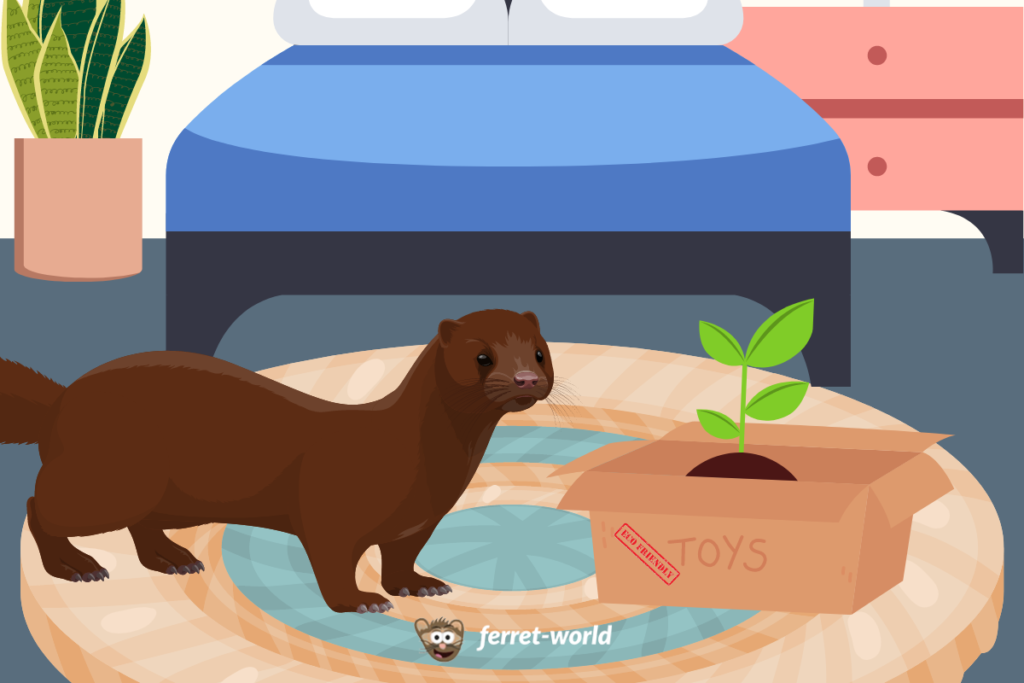
3 homemade ferret enrichment ideas and ferret toys, DIY style
Making your ferret’s toys at home is about more than just your weasel’s playtime, but the environmental impacts of your choices, too.
Pet owners have some of the biggest carbon footprints worldwide compared to those without animal companions. (A person’s “carbon footprint” is the total amount of greenhouse gases they release into Earth’s atmosphere, either directly or indirectly.)
The polluting gases that make up your pet’s carbon footprint come from its food, mostly, but toys are a source of major concern as well, for many of the reasons listed above.
At the same time, your ferret could be indirectly responsible for the release of up to 0.121-0.251 tons of greenhouse gases or GHGs just with its food alone if you rely on cat food.
Yet, even if you feed raw, your ferret’s carbon “paw print” can still be pretty big. Cats, pets whose standard care routines inspired those used for ferrets, take up 0.32-0.67 hectares (0.79-1.56 acres) each throughout their lifetime in the Netherlands, Japan, and China.
That said, it’s essential to identify other areas in your life where you can compensate for your and your weasel’s climate impacts, thereby improving your sustainability.
Scientists have yet to investigate the specific carbon “paw print” for ferrets; however, ferrets are often compared to cats in the type of care they require. So, an assessment of cats’ environmental impacts should give you a good idea of how to “greenify” your life with your weasel. These DIY toy alternatives will help you do just that.
Homemade toys for chewing and gnawing
You’ve probably heard it a million times now: Ferrets love to chew!
Weasels can never get enough of gnawing on things they shouldn’t be, such as your clothes and furniture. Thankfully, you don’t have to spend an arm and a leg to get your ferret’s problematic chewing under control.
Some of the best DIY alternatives to store-bought chewing and teething toys for ferrets include:
-
Freeze-dried or dehydrated meats
There’s no snack a ferret loves more than one made of animal protein! Why not combine it with much-needed daily playtime?
Dehydrated chicken feet and gizzards are some of the best chewing “toys” you can get for your ferret. It’s easy to prepare these treats at home, either in a dehydrator kitchen appliance or air-drying them for 24+ hours after cleaning, rinsing, and nail-clipping.
The best thing about this DIY ferret toy idea is that it can help minimize waste in both your and your ferret’s consumption habits.
For instance, you can purchase a whole chicken from a local farmer and use the entire animal for you and your fur-baby. It’s an excellent way to reduce your household waste and emissions!
2. Bobbing for treats
Although this doesn’t encourage chewing exclusively, your ferret will be happy to use its chompers for this exercise. Have your ferret “bob” for treats in a shallow container of water or plastic balls in a cardboard box.
Your weasel is sure to love hunting down a tasty snack or its favorite toy and using those teeth to grab hold of its target in the end. Extra chewy snacks like jerky and dehydrated pig ears can help the game last longer and satisfy the need to gnaw.
Warning: When using water, make sure to use a wide container to keep it shallow. Ferrets cannot swim well underwater, so you must not allow the water to get deeper than 2-3 cm (about 0.79-1 in).
Looking for a sustainable twist on this DIY toy idea?
Recycle the water used in the pool by using it in your garden, or better yet, use it as an alternative to flushing your toilet, a common source of water waste.
Few people know that they can flush their toilets by pouring roughly one gallon (in some cases, less) of water into the bowl. The leftover water from your ferret’s playtime is perfect for this, since “flushing is the biggest water hog in the house,” according to Water Calculator.
Older toilet models can waste as much as 5-7 gallons per flush, while modern low-flow types normally use 1.6 gallons. People usually flush the toilet about five times daily, so this adds up quickly.
Recycling the water from this DIY enrichment item can help chip away at your environmental impact.
Homemade ferret dig box
Another favorite pastime for ferrets is digging. But admittedly, it’s pretty tough to find an appropriate area for your weasel to fulfill this instinctual need. That’s why most ferret owners make dig boxes for their fur-babies to play with both indoors and out.
You can get an idea of how to design your dig box below.
3. Homemade dig box and garden combo
This is perhaps the eco-friendliest DIY ferret enrichment item you’ll find on this list. It’s an excellent multipurpose home essential that can minimize the environmental impact of your ferret’s diet, reduce your kitchen waste, and fulfill your ferret’s innate desire to dig.
How can a dig box do all this at once? Why, by containing a garden, of course!
You can give your ferret a designated place to dig with a container garden indoors, if you have a sunroom, garage, or similar area, or a raised bed garden out in the backyard.
Now, you can make this container for ferret recreation exclusively or as the multipurpose household essential just described. If you prefer the former, it’s best to fill it with low-impact, renewable materials like coconut fiber and hemp-based substrate.
Ferret owners that prefer the latter must be careful to choose a soil that is non-toxic to ferrets. This means avoiding artificial, chemical-heavy fertilizers, too. Instead, you can nourish your garden’s soil with ferret-safe kitchen scraps and vermicompost. That way, you won’t have to worry about your ferret’s safety while it’s digging.
Also, make sure you only grow ferret-safe plants, especially if you don’t have a barrier to keep it from digging them up. For example, here’s how you should separate the digging section from the garden:
What You’ll Need:
- 120 x 60 x 20 cm (47 x 24 x 8 in) Angeliox 38 gal thickened non-woven fabric grow bag
- Eco-Earth Compressed coconut fiber (also known as coco coir; this is typically marketed for reptiles, but it’s okay to use for ferrets, too)
- (Optional) Old Dominion Hemp small animal bedding
- Organic worm castings
- Ferret-safe plants
- Organic Plant Magic pet-friendly organic potting soil
- Chicken wire
Instructions:
- Get a large enough container or raised bed that your ferret can fit its whole body inside and play in the dirt at a reasonable distance from the plants.
- Note: Some ferrets like to scoot around when they dig, and often fling the dirt all over the place. Make sure the container or raised bed is large enough to accommodate this!
- Fill the container or raised bed with the soil mixture and line the plants across the back of the container or along one side.
- Close off the garden section with a wall of chicken wire. (This isn’t 100% ferret proof, so make sure to supervise whenever it’s time to dig.)
It’s worth restating: Take care to grow only ferret-safe plants in a multipurpose eco-friendly dig box. For more information on which plants to avoid, see this overview by the American Ferret Association.
Bonus suggestion: Ferreting
Nowadays, too few ferret owners are aware of all the outdoor enrichment opportunities for ferrets. Many have been conditioned to turn to mass-produced commercial toys to keep their weasels happy. While they can help to combat your weasel’s boredom, they’re not enough to fulfill its most fundamental instinctual desires. Ferreting can fill that void.
This sport is one of the oldest activities shared between man and weasels. In fact, Europeans trained these animals to “ferret out”, a term for hunting rodents and rabbits with a handler.
Still, after centuries of captive breeding, ferrets still aren’t considered to be domesticated. That’s right, they’re still somewhat wild, even after they were adopted as companion pets (not hunting partners) in the ‘80s, thanks to the beloved ferret sidekicks, Krodo and Podo in the 1982 film, “The Beastmaster.”
Although many ferrets bred in captivity are “designed,” so to speak, to be docile, they all retain a profound need for hunting and exploration. Still, this doesn’t mean that ferreting is a suitable choice for outdoor recreation for everyone.
For instance, American ferret owners will be hard-pressed to find ferreting opportunities because of geographic differences in rabbit nesting behavior. Throughout the United Kingdom, rabbit species build interconnecting networks of tunnels with various entry and exit points called “warrens.”
These housing structures, which don’t appear much in North American landscapes apart from invasive European rabbit species, directly influenced ferreting methods.
Since native U.S. rabbits tend to build their nests in shrubbery, traditional ferreting wil be much more challenging for Americans. Why? A historical account from Greek historian, Strabo (63 B.C. – 24 A.D.), described how the Romans used ferrets to mitigate rabbit overpopulation:
“The ferrets with their claws drag outside all the rabbits they catch, or else force them to flee into the open, where men, stationed at the hole, catch them as they are driven out.”
To accomplish this, handlers (the hunting ferrets’ human companion) would position themselves at a warren’s entry and exit points, according to illustrations dating back to the Middle Ages. They’d dispatch a ferret into the warren and wait with nests, dogs, or hawks to trap the fleeing rabbits.
Since nesting structures in the United States are arranged differently, this activity may not be the best for some folks. If you find that there are too few ferreting opportunities near you, use the tunneling, digging, and gnawing DIY tips above to simulate that much-needed hunting experience.
Live sustainably with your weasel
Although ferrets are satisfied by relatively simple pleasures, you’ll need a wide variety of toys and enrichment items to keep them fulfilled.
Still, this doesn’t mean you have to limit your options to those mass-manufactured pet toys that end up wasting away in landfills. Instead, you can shrink your environmental impact and keep your weasel entertained in one fell swoop by switching to one of the sustainable toys discussed here.
Select the best eco-friendly DIY ferret enrichment idea from above and makeover your fur-baby’s play routine today!
